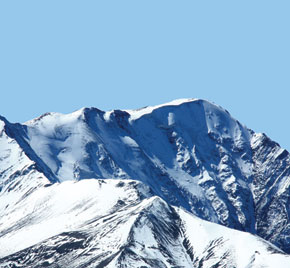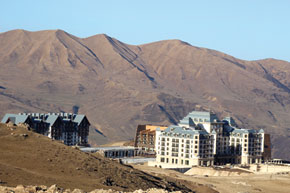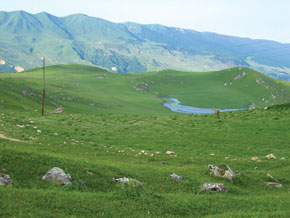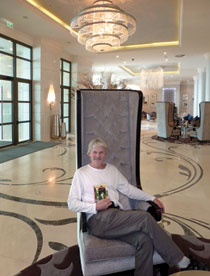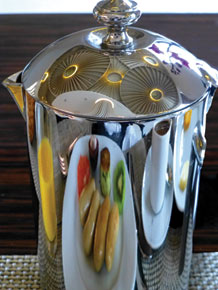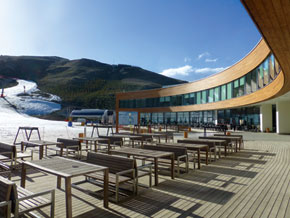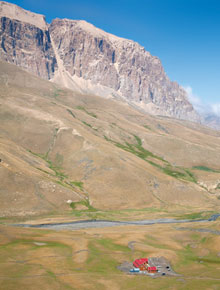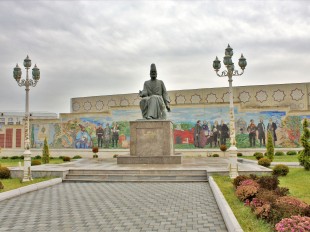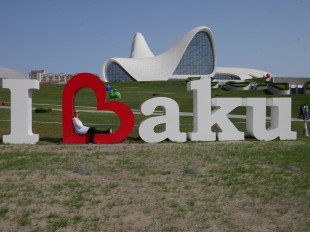I’m staring wistfully at reflections in an ultra-polished, stainless steel coffeepot. It sits on my breakfast table in the sumptuous Pik Palace Hotel, a majestic yet quirky five-star design statement at Shahdag, Azerbaijan’s fast-expanding new ski resort. Beyond the delicate purple table orchid, the reflections are a fascinating overlapping series of what look like gigantic mushrooms flying skywards – part of the star-burst ceiling pattern of the resort’s alluring Alpina restaurant. Outside the rocky crag of Baltaqaya is streaked with snow. It was a glorious sight in yesterday’s sunset glow, and looked magical in the light of a pendulous moon that bathed the night with silver.
Shahdag resort
This morning a total white-out is hiding the scene – a fine time for me to reflect on the series of astonishing changes that I’ve witnessed here in the 15 years that I’ve been visiting. Even two years ago it was impossible to imagine I’d be starting my morning with great coffee, fresh carrot juice, nouveau cuisine hash browns or strawberry brioche. And even in the newly decadent Azerbaijan I’m flabbergasted to be served Dubai-sourced mangosteen, the ultimate ambrosia of fresh tropical fruit. Such things would have been unthinkable when I was researching the last edition of my guidebook in 2007-09. There wasn’t so much as a kebab barbecue. No cafe. No buildings whatever. Back then I had included the Shahdag resort site as one of the “emerald green meadows [that] soar up to craggy mountain peaks of astonishing grandeur”. The main feature here was a large pond set in lush bouncy turf, a place where shepherds from nearby Aldash village would water their flocks. Hiking near here a decade earlier, a shepherd once rescued me in the nick of time when I’d been pursued by his slavering, over enthusiastic dogs, hounds whose ears had been cut off in the Caucasus fashion to make them angrily ferocious. You’d be angry too!
Today there’s no sign of sheep. Or dogs. All traces of the pond have disappeared. Most of the turf has been removed and the area flattened to form a commercial square already flanked on three sides by a trio of dazzlingly stylish five-star hotels. An aqua park is planned for the fourth edge and arcades of shops and cafes are taking skeletal shape. On the slope behind, a snow groomer has descended the end-of-season piste. Ski lifts – that had still been a distant glimmer in a planner’s eye back in 2009 – have already started the day’s operations. A far higher gondola cable-car is under construction, planned to whisk visitors to the high pastures from which, by around 2017, new black runs will descend from a Henry Chebaane designed peak-top restaurant. Trucks and earth movers are already shuttling about on the makeshift access roads. One of these follows the start of the old lane 5-km west to Laza village. For decades that was less of a road than a series of ruts through the soft, flower-filled sheep lawns. Bathed in birdsong, these converged to chicane across a pass between powerful, spiked rocks then descended a Landrover-challenging slither into the jaw-dropping setting of the Laza Valley. Today that road has been graded and widened. Massive quarrying has removed the ever-present landslide danger, albeit scarring the aesthetics of the pass, which now sidesteps the rocky sentinels before the still precipitous descent into tiny Laza village.
Laza village
The village setting remains as awesome as ever – frozen waterfalls beg ice climbers to reach for axes and crampons. A little-changed scattering of homes remains casually set around an abrupt central rock, shaped like a three-storey extracted molar. Fields have pyramids of manure awaiting springtime spreading. A few stacks of pale cream breeze-blocks hint at transformations to come and a new red-purple building masks the simple tin-roofed mosque from view, but essentially the village feels much as it was when I first arrived here by horse-trek back in 1998. My old friends the Azizov family are still here – school teacher Khaled looking like a “gold toothed Jeremy Paxman”, Zahid who showed me the village’s carpet washing spot one sparklingly clear spring morning, and English-speaking Mevlud now employed as a ski instructor down in the Shahdag resort. A decade ago he had been a walking and climbing guide for the trickle of adventurers who used to explore the heady pinnacles of Qizilqaya, the giant bull-head mass of Mt Shahdag or the photogenic shepherds’ trails across to fabled Khinaliq (Xinaliq), Azerbaijan’s highest and most linguistically unique village.
Bureaucratic block
This inspirational day-hike and most of the once-popular climbs are currently out of bounds, curtailed by a pair of annoying bureaucratic details. The first started when Laza inherited its new border guard station – a large incongruously city-style administrative building on the otherwise pristine grassy slopes across the river. Now long-distance hikers arriving in Laza can be expected to be treated with suspicion or worse – did you wander in from Chechnya?! Meanwhile the inclusion of the valley beyond Laza as part of the Shahdag National Park further constrains exploration unless visitors come pre-armed with a special document from the Ministry of Ecology and Natural Resources in Baku. Bizarrely there appears to be no way to simply purchase a day ticket in situ. However, as the Shahdag Resort grows into a year-round visitor destination, it is hoped that such absurdities will be swept into history.
Mind-blowing ambition
Back at the Pik Palace, lazing on mounded fluffy pillows on a bed the size of a sports pitch, I watch a Shahdag promotional video. It conjures up scenes of hiking, horse riding, quad and mountain biking – the logical seasonal extension of leisure activities once spring warms up and the snow canons can no longer pump out a piste for Baku’s beau monde ski-set.
Time has come for me to leave the luxury of this “fairytale ice palace” with its acres of white marble, its brilliantly sinuous tables and blanched Tim Burtonesque Mad-Hatter seats. Inspired by the Gstaad Palace in Switzerland’s Bernese Oberland, the Pik Palace underlines the style-conscious metamorphosis that is gripping 21st century Azerbaijan. And the sheer ambition of the Shahdag resort is mind-blowing in itself.
Driver Fidan takes me back to Qusar, the nearest town 40-km east. This journey took me well over two juddering hours by PAZ bus back in 2004 but has been cut to a mere 35 minutes on fine new asphalt. In a flash we zip past Aniq village, which for years had maintained its Lenin statue – “that’s long gone” says Fidan without regret.
Paradise
Some 10 km further we pass Khuray. Years ago I’d found a Laza-Qusar ride with a kindly gentleman whose taxi driving was a supplement to his modest salary as a teacher at Khuray school. He had proved a most obliging chauffeur, stopping without complaint for many a photo including a timeless scene of farmers scything the roadside verge for fodder. As we approached Khuray he had suggested that I really needed a photo here. Beaming with delight he pulled over. I was baffled. Apart from a name that sounds merrily like “Hooray!” the village could not be more ordinary: tin roofed houses strung along a raised ledge across the river; an unremarkable backdrop of low wooded hills; a muddy access road across a narrow bridge. But for the teacher-driver this was paradise. Bursting with pride he gestured towards the scene, gushing, Look! This is my village! How could it be more beautiful? We have water. We have trees. We have apples. We have everything. We even have electricity! Have you ever seen anywhere better to live?
Now I can never pass Khuray without a glowing sense of delight... a reminder of the humanity that has always been the core inspiration for my travels in this fast changing yet ever hospitable land.
About the author: Mark Elliott’s guidebook Azerbaijan with Excursions to Georgia was first published in 1998 is and now in its 4th edition. In a series of articles for Visions, he is revisiting regions of Azerbaijan to observe and reflect upon the astonishing changes that have occurred over the past 15 years.
